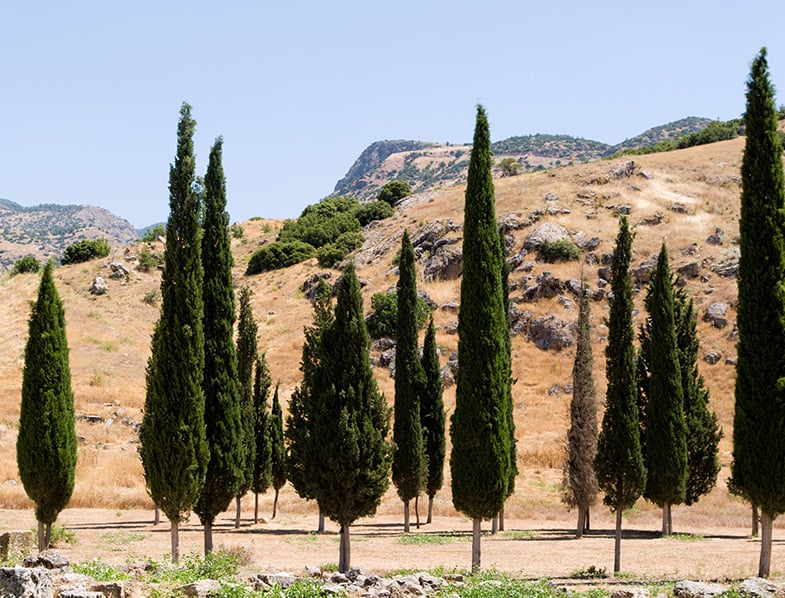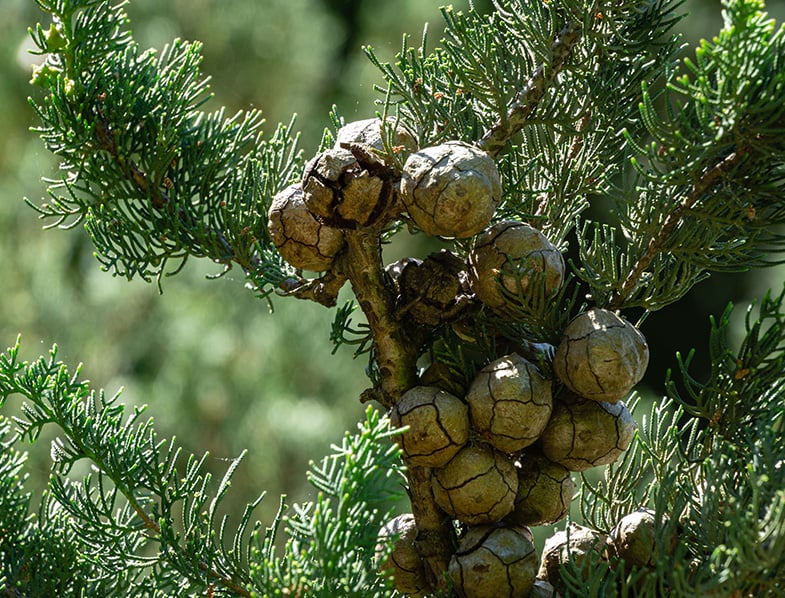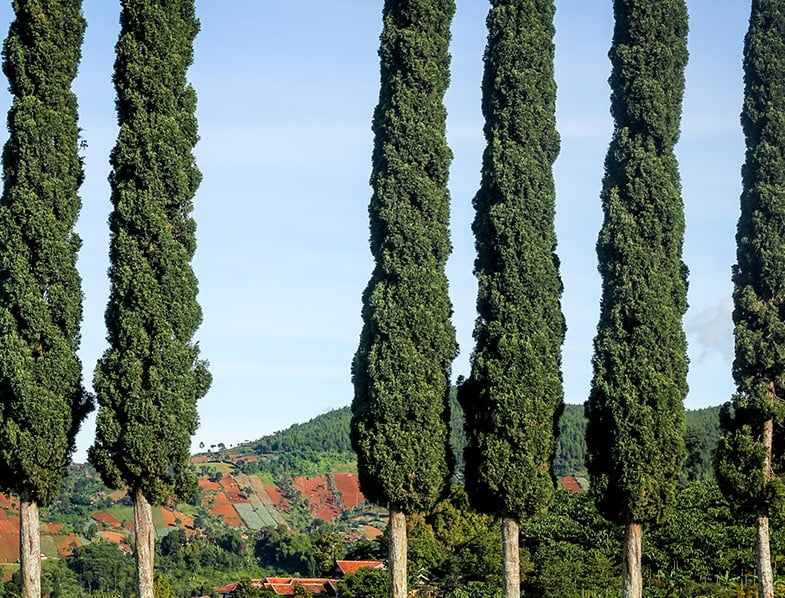How Does the Mediterranean Cypress Tree Draw Water
Cupressus sempervirens is commonly called the Italian or Mediterranean cypress tree, but this tall coniferous tree occasionally goes by plenty of other names, too — including the Tuscan cypress, Persian cypress, pencil pine (owing to its striking columnar growth habit), and perhaps most interesting of all, the churchyard cypress.
This tree belongs to the Cupressaceae (cypress) family, which counts between 16 and 25 distinct members, depending on which botanist you ask.
The Mediterranean cypress is a tall and exceptionally "spiky" evergreen conifer. It looks its best when planted in larger clusters of "living monuments", and the nickname "churchyard cypress" comes from the fact that it's often found around cemeteries in its native zones, where the trees look to be watching over the dead.
Those gardeners who do not have space to plant multiple Mediterranean cypress trees can rest assured that they also look wonderful on their own, or when planted alongside smaller evergreens.
While mature Mediterranean cypress trees thrive with very little care, in the right environment, young saplings are a little more labor intensive.
About the Mediterranean Cypress
- Cupressus sempervirens is considered to be a medium-sized cypress. This coniferous evergreen tree has an upright growth habit. The variety Cupressus sempervirens 'Stricta', which grows into an extremely slender tall tree with a rather modest spread, is the Mediterranean cypress that's famous for its columnar look.
- These evergreen trees are mainly native to the Mediterranean region, where they have been growing for millennia. Their original growing zone includes Italy, Malta, Croatia, Israel, Lebanon, and Syria. These days, however, the Mediterranean cypress can be found as far afield as Hawaii. These trees prefer to grow in coastal regions and are salt tolerant, and do well in practically any region with warm summers and mild winters.
- This tree was given the epithet sempervirens, which means "evergreen" — rather appropriate.
- You may subconsciously associate these trees with Italy, which is logical because Mediterranean cypress trees have featured heavily in Italy's travel ads over the years, but they're also linked with a few rather interesting myths. Cyparissus from Greek mythology was said to be overcome with grief after accidentally killing his treasured horse, and subsequently transformed into a Mediterranean cypress tree. This is perhaps the root of the tree's persistent association with grief and mourning.
- Some people claim that the Mediterranean cypress, which has indeed been proven to have existed for millennia, was used to construct Noah's ark as well as the Jewish Temple in Jerusalem.
- Mediterranean cypress trees have become popular in manicured corporate gardens, but they can look amazing in a variety of settings. If you are considering planting the Mediterranean cypress in your own garden, you will gain a tall tree that provides an excellent wind cover when planted in lines. The 'Stricta' variety of the Mediterranean cypress can be used as a centerpiece in smaller gardens, as these trees do not spread very widely.
- These trees are rather long-lived — the oldest known Mediterranean cypress, which is growing in Iran, is believed to be over 4,000 years old.
- The shoots of the Mediterranean cypress can be used to make a fragrant essential oil that is often incorporated in perfumes.
- Despite the fact that established Mediterranean cypress trees are considered to be easy to grow and take care of, these trees do fall victim to mites, cypress aphids, and bagworms sometimes, and can also develop a variety of fungal infections.
- Cypress trees are generally non-toxic to cats and dogs, but the needles still should not be ingested.
- This tree is generally moth-resistant, and its bark and needles make for an excellent natural moth repellent for your wardrobe!

Mediterranean Cypress Features: An Overview
- The Mediterranean cypress, Cupressus sempervirens, is a tall evergreen conifer with dense blue-green needles. Cupressus sempervirens tends to grow into the mildly pyramidal shape characteristic to many needled evergreens, while Cupressus sempervirens 'Stricta' is the variety you will want to get if you are hoping to add the column-like slender type of Mediterranean cypress to your garden.
- The Mediterranean cypress tree grows quickly in its first few years of life, after which its growth rate is slowed. When fully mature, these trees will hardly grow at all.
- Mediterranean cypress trees typically grow to be 40 to 70 feet (12 to 22 meters) tall. Depending on the variety, they may have a spread of only three to six feet (one to two meters). This makes uniquely suitable to people who are hoping to enjoy a tall tree in a small garden, as well as for those who would like to create tall wind barriers or living privacy hedges. Keep in mind that these trees take as long as five decades to reach their final height.
- The evergreen needles of the Mediterranean cypress have a blue-green color, and are one to three inches (three to eight centimeters) in length. They are mildly fragrant while growing on the tree, but offer a fresh scent explosion when the leaves are crushed or burned.
- The fruits of the Mediterranean cypress are festive copper brown cones, which at time seem to sparkle. They appear during the fall and are less than an inch broad and wide, with a spherical or oval shape.
- Although Mediterranean cypress trees do not flower, they do produce pollen cones during the spring. These are green and fairly insignificant.
- These trees have a dark brown or gray bark that is fairly smooth in texture, with some furrows. The color of the bark continues to evolve as your Mediterranean cypress matures.

Growing Mediterranean Cypress Trees
These Mediterranean trees thrive in environments where they will receive at least six hours of sunlight a day, and they are extremely drought-tolerant. Cupressus sempervirens can thrive in climates with hot and fairly dry summers, and prefers milder winters.
Although mature Mediterranean cypress trees are quite cold hardy, and can survive frosts of up to -20 °C (-4 °F), young trees will perish when exposed to extreme cold. Mediterranean cypress trees prefer wetter winters. In the US, the Mediterranean cypress can be grown in hardiness zones 7b through 11, and this tree also does well in the UK.
It is best to plant these trees in sandy or loamy soil that drains well, but the Mediterranean cypress can also grow in clay or chalky soil and is not demanding when it comes to pH levels. If you are looking to design a coastal garden, it is additionally good to know that Mediterranean cypress trees are resistant to salty soil and salt spray. While they are often planted as wind buffers, however, they do not appreciate especially windy conditions, which can cause their branches to break.
Bestseller No. 1

Italian Cypress | Small Tree Seedling | The Jonsteen Company
- Grow your own Italian Cypress, an unmistakable exclamation mark of beauty and formality in landscapes throughout the world!
- 100% guaranteed: If your seedling perishes, we are happy to provide a replacement small-sized seedling for just the cost of shipping/handling
- Seed-grown on California's Redwood Coast
- Transplanting and care instructions included
- Trees can provide a natural barrier against high winds, temperatures, noise pollution and soil erosion, all while benefiting local air quality, wildlife and property values — a Jonsteen seedling will only grow in value and beauty!
Bestseller No. 2

20 MEDITERRANEAN CYPRESS TREE Green Spire / Pencil Pine / Indian Cedar Seeds
- BLOOMS: N/A
- HARDINESS ZONE: 8 - 11
- PLANT HEIGHT: 20 - 40' . . . PLANT SPACING: 4 - 6'
- LIGHT REQUIREMENTS: Sun - Part Shade . . . SOIL / WATER: Average - Dry
- These evergreen beauties are known for their extremely tall, thin appearance that makes them perfect for containers, in small spaces, or grown in a line to make a living fence.
Bestseller No. 3

Italian Cypress Tree | 1 Live 4 Inch Pot | Cupressus Sempervirens | Formal Elegant Mediterranean Style Plants
- Grown, packaged and shipped exclusively by Florida Foliage. A Mediterranean garden classic that adds a strong verticle accent. An ideal specimen to dominate a landscape with its densely branched, narrow, columnar form. Excellent next to tall buildings or lining a long drive for a formal look.
- Grows easily in a wide range of soil types, provided good drainage. Water deeply and regularly during the first growing season to establish an extensive root system; reduce frequency once established. Feed with a general purpose fertilizer before new growth begins in spring.
- With an elegant, narrow silhouette that grows up to 3 feet each year, the Italian Cypress is one of the top trees to increase your property value. Especially since it's tolerant of many climates and gives height to your foundation plantings without taking up a lot of room.
- Architects use Italian Cypresses to cover vertical drain-pipes, soften corners and vertical edges, and even act as elegant property dividers. Plus, you can plant them in large pots to frame your front entryway or add elegance to your back patio or pool. Because they grow nearly anywhere and adapt to an array of soil types, Italian Cypresses are second to none when it comes to landscape luxuriance.
- Unlike most evergreens, the Italian Cypress does not grow in a pyramidal fashion. These popular trees boast narrow, columnar growth, practically reaching straight up without ever growing very wide. So, when they reach your desired height, you can simply cut the top. It's that effortless.
In terms of fertilizer, gardeners are advised to feed their Mediterranean cypress trees fertilizer once a year, during the late winter or early spring. A balanced 5-10-10 fertilizer regimen is recommended to help these trees grow. This can be raked into the soil and followed by a deep watering.
Keep an eye out for drooping branches, as well. These are generally a sign of overwatering, but should be removed during the spring time, when the tree emerges from its dormancy, to promote new growth. Besides that, these trees do not require much, if any, pruning — their naturally slender shape almost resembles a basic topiary shape, and Mediterranean cypress trees look extremely manicured without much interference on your part.
Watering Mediterranean Cypress Trees
The Mediterranean cypress tree thrives in hot and dry conditions as it is native to the Mediterranean, where has needed to adapt to occasional long periods of drought. Because of this, your Mediterranean cypress won't actually need that much water, in fact, you shouldn't be watering a mature Mediterranean cypress at all if your area receives ample rain, not counting the deep watering you will want to offer the tree during the spring, to work the fertilizer into the ground.
Even if there is no rain for a while, you still don't need to water this tree, as it is very drought resistant! It will, however, appreciate some light watering once in a while.
However, if you are just starting out growing your Mediterranean cypress, and it hasn't even taken root yet, you should know that young saplings do need additional watering and care. Watering brand new Mediterranean cypress helps it grow! As with mature trees, it is important to provide young saplings with well-draining soil and full sun.

Propagating Mediterranean Cypress Trees
Cupressus sempervirens can be propagated from seed or through cuttings. The hardy copper-colored fruit cones the produces during the fall can naturally remain on the tree for years, and will not open by themselves — so if you are wondering how to access the seed inside, you will be interested to learn that heat is the way to get them to pop open.
Keep the seeds in the fridge for 30 days to activate them, in moist sandy soil, and then sow them directly in your garden if you live in the right climate. While you will be beginning a very long adventure, as Mediterranean cypress trees take up to 50 years to reach their ultimate size, it is good to know that the seeds germinate very easily.
Should you be hoping to clone your mature Mediterranean cypress, for its needle color or other desired characteristics, propagating from seed is not the right way to go — new Mediterranean cypress trees will not have the same features as the parent plant.
That is why many gardeners will want to propagate the Mediterranean cypress through cuttings, instead. Here's a look at the process:
- Take your Mediterranean cypress cuttings from a healthy, strong, and mature parent tree in mid-summer to early fall. Specifically, if you want to take evergreen current growth cuttings, take them in early fall, while softwood cuttings should be taken in the summer.
- You can use a sharp tool, a knife or pruning shears, to cut off a long branch, which should be cut somewhere near the bottom of your parent plant.
- After you have your cutting, you'll want to divide it into multiple smaller parts, including three to four sets of needles. The final cuttings should be around six inches (15 centimeters) long. Make sure to cut off all the needles at the bottom of your cutting to allow the cutting to take root.
- If you want to give your Mediterranean cypress cutting a better chance at succeeding, dip it in rooting hormone, shaking off the excess.
- Plant your newly-cut branch in a container with moist soil. To keep the cutting in a humid environment, cover it with a plastic bag.
- Now, just continue keeping the soil moist, placing it in a location where it will receive full sun, and if you're lucky, the cutting can be planted outside after just a year.
Growing the Mediterranean Cypress as a Houseplant
Some people grow Mediterranean cypresses as houseplants. This is sometimes done with the intention of later transplanting them to the garden, but these trees can also be trained as bonsai trees with the right care.
If you would like to attempt to grow a Mediterranean cypress indoors, the plant will need the same conditions as outside — full sun and sandy or loamy and well-draining soil. They will need occasional light watering when the soil has completed dried out; most people will be tempted to overwater their Mediterranean cypress houseplants, but that should be avoided at all costs.
In Conclusion
Mediterranean cypress trees may take decades to reach their ultimate size, but even younger trees are attractive, serving as accent plants, wind barriers, or privacy hedges.
Once mature, these trees are easy to care for, thriving with very little water in a wide range of soil conditions, and requiring fertilizer only once a year. Don't have a garden? You could join the ranks of the brave and attempt to grow Cupressus sempervirens as a beautiful bonsai indoors! I
Source: https://gardenbeast.com/italian-cypress-guide/
0 Response to "How Does the Mediterranean Cypress Tree Draw Water"
Post a Comment